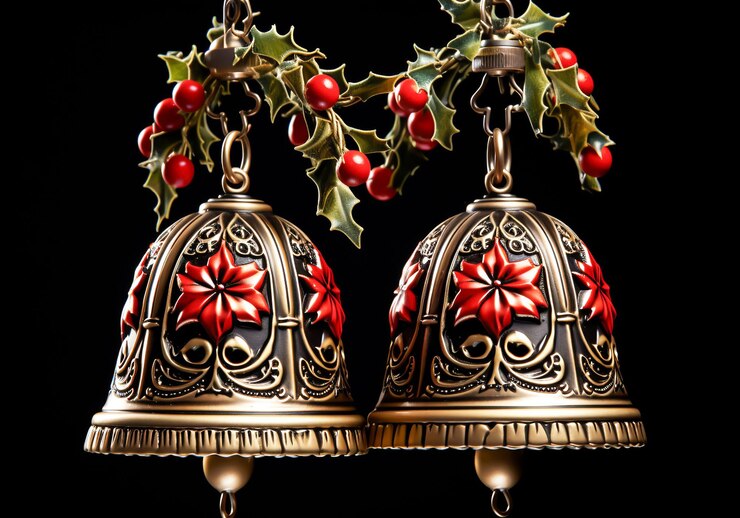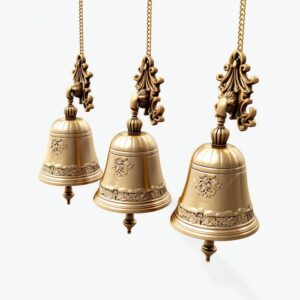
In various cultures, the act of hanging a silver or brass bell near the entrance holds profound significance. It’s more than just a decorative element; it’s believed to foster positive vibrations and provide protection for the home and its occupants. Placed strategically, whether at the window or doorway, bells are thought to repel negative energies that may attempt to infiltrate the space. This belief originates from the sound and vibrations produced as the bells sway in the wind. The soft, melodious tones and gentle vibrations emitted are perceived to create a soothing ambiance, acting as a shield against malevolent forces.
By embracing this age-old tradition, individuals partake in a simple yet deeply meaningful practice to nurture harmony and tranquility within their homes. Hanging a bell near the entrance symbolizes more than cultural tradition; it establishes a tangible link to the notion of cultivating a sanctuary of positivity amidst life’s hustle and bustle. Consequently, this ritual serves as a gentle reminder to prioritize emotional well-being and the cultivation of peace amidst the daily grind.
Symbolism of Bells
Bells carry deep symbolism across different cultures. In some religions, such as Hinduism and Buddhism, bells are used in rituals to invoke the divine and dispel negativity. They symbolize purity, enlightenment, and spiritual awakening, serving as a bridge between the earthly and divine realms.
Feng Shui and Bells
In Feng Shui, the ancient Chinese practice of harmonizing energy flow, bells play a vital role in creating a balanced environment. Hung near entrances, bells are believed to attract positive energy (Chi) and repel negative forces. Proper placement and alignment of bells are essential for maximizing their beneficial effects.
Protection and Warding Off Evil
One of the primary purposes of hanging bells near entrances is to provide protection against malevolent forces. Across cultures, bells are thought to act as guardians, warding off evil spirits, and preventing negative energies from entering the home. This belief reflects humanity’s enduring quest for security and well-being.
Welcoming Prosperity
Bells are also associated with prosperity and abundance. The melodious chime of a bell is believed to attract good luck and prosperity into the household. Many cultures incorporate bells into rituals and ceremonies aimed at ushering in prosperity and success.
Decorative Purposes
Beyond their symbolic significance, bells serve decorative purposes, enhancing the aesthetic appeal of entrances. From intricately designed temple bells to rustic wind chimes, bells come in various shapes and sizes, adding charm and character to doorways.

Practical Uses
In addition to their symbolic and decorative roles, bells serve practical functions. Hung near entrances, bells announce the arrival of visitors, alerting occupants to their presence. The gentle tinkling sound of a bell also creates a sense of peace and tranquility, welcoming guests into a harmonious environment.
Modern Interpretations
While rooted in tradition, the practice of hanging bells near entrances has evolved in modern times. Many homeowners embrace this tradition not only for its cultural significance but also for its aesthetic appeal. Bells are now available in contemporary designs, blending seamlessly with modern décor styles.
Choosing the Right Bell
When selecting a bell for your entrance, consider factors such as material, size, and design. Whether opting for a traditional brass bell or a sleek, minimalist design, choose one that resonates with your personal taste and complements your home’s aesthetic.
Installation Process
Proper installation is key to maximizing the benefits of hanging bells near entrances. Follow guidelines for placement and alignment, ensuring that the bell hangs securely and can produce clear, resonant tones. Take care not to obstruct the bell’s movement or impede its sound.
Caring for Your Bell
To maintain the beauty and functionality of your bell, practice regular maintenance and cleaning. Depending on the material, use appropriate cleaning methods to remove dirt and tarnish. Inspect the bell periodically for any signs of damage or wear and address any issues promptly.
Bells in Popular Culture
References to hanging bells abound in popular culture, ranging from literary works to cinematic masterpieces. Bells feature prominently in folklore, mythology, and symbolism, reflecting their enduring significance in human consciousness.
Global Variations
While the practice of hanging bells near entrances is widespread, customs and traditions vary from region to region. From the temple bells of Asia to the wind chimes of the West, each culture infuses its unique symbolism and meaning into this timeless tradition.
Conclusion
In conclusion, the practice of hanging bells near entrances is steeped in tradition, symbolism, and cultural significance. Whether as symbols of protection, harbingers of prosperity, or simply as decorative elements, bells hold a special place in the hearts and homes of people around the world. Embrace this timeless tradition and invite the blessings of peace, prosperity, and protection into your home.
FAQs
Are there specific rituals associated with hanging bells near entrances?
Yes, many cultures have rituals or ceremonies for installing bells, often involving prayers or blessings to imbue the bells with positive energy.
Can hanging bells near entrances really ward off evil spirits?
While beliefs vary, the symbolic act of hanging bells is thought to create a protective barrier, whether against negative energies or unwanted entities.
What materials are commonly used to make bells for entrances?
Brass and silver are popular choices due to their durability and resonant properties, but bells can also be made from other metals or even wood.
Do bells need to be rung regularly for their benefits to be effective?
While ringing bells can enhance their positive effects, simply having them hung near entrances is believed to provide ongoing protection and blessings.







